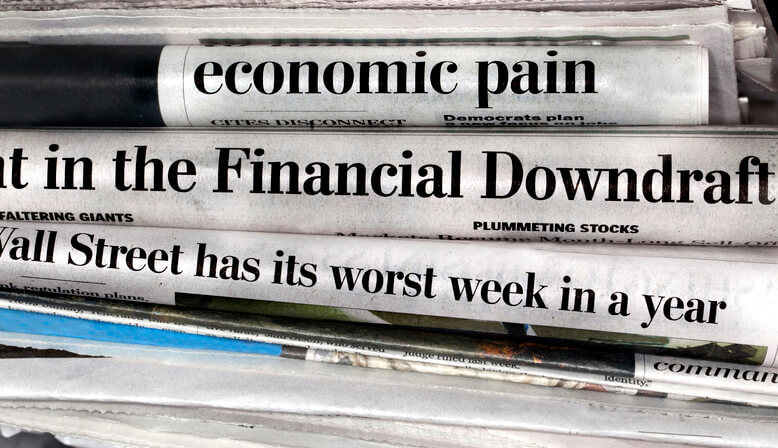by Paul Broughton
Recent economic data, the spread of the coronavirus, falling interest rates, and a flattening yield curve may be giving investors pause. The S&P 500 dropped 1.5% last Thursday and Friday to lock in a 1% decline for the month. Recent adverse news has been concerning and worth watching, but it can also be viewed as a positive for the markets by indirectly helping to extend the economic expansion by keeping the Fed’s current accommodative monetary policy in place. And the markets may very well continue to climb the proverbial wall of worry as a result. (Please see last week’s commentary regarding the coronavirus: link here.)
Bad news on the manufacturing front persisted through the last five months of 2019, indicated by below-50 levels of the ISM Manufacturing PMI report. Boeing’s 737 Max problems have led to thousands of job layoffs at its related suppliers, and the halting of production will further hamper the manufacturing PMI in the months ahead. The weakness was also likely fueled by the lengthy trade war with China. That dispute has been partially worked out, but not without significant implications for capital spending. And now we also have the coronavirus scare which is slowing global economic activity, more broadly, although the size of the impact to global GDP remains to be determined.
Beyond these possible signs of a slowdown, the yield on the 10-year Treasury has dropped sharply from last February’s 2.70% to today’s 1.53%. This decrease in yield would seem to indicate a lower growth outlook for the U.S. economy. Investors may be further concerned that the Fed’s favorite indicator of inflation (the PCE Core Deflator) remains stubbornly around 1.6%, as compared to its 2.0% target. Short-term rates have fallen by less, so the yield curve (the 10yr yield minus the 2yr yield) flattened in January by about 17 basis points after steepening sharply in the fourth quarter of last year on the hopes of global reflation. Some view a flatter yield curve as an early indicator of an impending recession.
That all seems pretty bad, but let’s take a closer look.
Manufacturing appears poised to recover. The above-mentioned slowdown in manufacturing is likely to prove transitory. Trade uncertainty weighed heavily throughout the back-half of last year, but now that the U.S. and China are implementing the first phase of a trade deal, tariffs are falling, so we could see a rebound in manufacturing in the months ahead. Indeed, the January ISM Manufacturing PMI came in at 50.9, the first report in the expansionary territory since July 2019. That will likely be boosted further once Boeing gets its 737 Max recertified.
Low interest rates are not alarming. The low yield on the 10-year Treasury could be interpreted as a sign of a slowing U.S. economy, but other explanations are more compelling. For one, large global institutional buyers would rather own the U.S. 10-year than the German 10-year, which is yielding a negative 0.44%. And beyond global bond market conditions, the coronavirus scare itself could be responsible for taking about 30 basis points off the 10-year since mid-January. The positive side of a 1.53% 10-year Treasury is its implications for mortgage rates and the U.S. housing market. The current national average Bankrate 30-year mortgage rate is 3.64% – an obviously low and attractive rate. An excellent proxy for the health of the U.S. housing market is the iShares U.S. Home Construction ETF – it’s up about 13% since early October and up 41% over the past twelve months. It’s outperformed the 23% increase in the S&P 500’s over the last twelve months by a wide margin. U.S. housing makes up about 15% of our economy and the outlook for 2020 remains positive.
Policy can counter bad news. The trade dispute with China led to uncertainty and in turn a slowdown in manufacturing. Add to that the recent Iranian conflict, the impeachment proceedings in Washington, election-year politics, and now the global coronavirus concerns. The consensus forecast for U.S. GDP growth in 2020 is a solid 1.8% to 2% and inflation remains relatively subdued. We may be set up for a rebound in manufacturing, but elevated uncertainty this year should persist. All of these issues likely mean that the Fed will lean in favor of keeping its current accommodative monetary policy in place, which gives the current economic expansion more room to run.
ACM is a registered investment advisory firm with the United States Securities and Exchange Commission (SEC). Registration does not imply a certain level of skill or training. All written content on this site is for information purposes only. Opinions expressed herein are solely those of ACM, unless otherwise specifically cited. Material presented is believed to be from reliable sources and no representations are made by our firm as to another parties’ informational accuracy or completeness. All information or ideas provided should be discussed in detail with an advisor, accountant or legal counsel prior to implementation. All investing involves risk, including the potential for loss of principal. There is no guarantee that any investment plan or strategy will be successful. ©ACM Wealth

